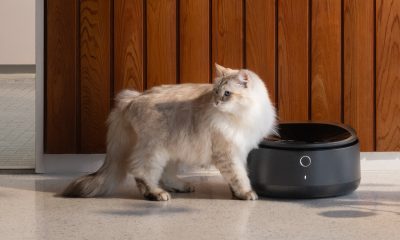Finance
Flexible display startup Royole is now mass producing its OLED screens


Bill
Liu, cofounder and CEO of Royole, which has designed and is
starting to mass produce a super-thin flexible
display.
Troy
Wolverton
-
Flexible displays have long been a dream of
futurists. -
Such screens have been commercially available for about
five years now, but few devices really show off their bendable
property. -
That may be about to change, thanks in part to Royole,
a startup based in the San Francisco Bay Area. -
Founded by a Stanford PhD graduate, Royole has designed
and is starting to mass-produce a super-thin flexible screen
that could be used in everything from t-shirts to portable
speakers. -
Its new screen technology is coming on the market just
in advance of the expected debut of the first foldable phones
that will be built around similar technology.
It’s the stuff of science fiction, and plenty of tech trade shows
— a screen so thin and flexible that it can be rolled up into a
cylinder as small as a cigarette or hung on a wall like
wallpaper.
Many believe those properties could spark a revolution in gadget
design. And that revolution may finally be at hand.
If it is, you might thank Bill Liu.
Liu is the chairman and founder of Royole, which specializes in
making flexible displays and sensors.
The company, which is based in the San Francisco Bay Area, has
come up with a way to make a full-color, high-resolution screen
that is just 0.01 millimeters thick — thinner than a sheet of
standard copy paper.
Royole just opened a new factory in China that will mass produce
the displays and is already working with partners to get them
installed in everything from t-shirts to automobiles to
smartphones.
And its screens, thanks to their flexibility, could soon be used
it lots of ways and places that other displays just can’t.
“You can see this will change a lot of different industries,” Liu
said in a recent interview with Business Insider. He continued:
“This is not a concept. This is not sci-fi.”
This is not a concept. This is not sci-fi.
Royole’s screens are based on OLED technology, in which the
lighting elements are built into the display itself. Unlike the
OLED screens that are in some higher-end televisions, which are
typically placed on a rigid base like glass, the lighting
elements in Royole’s screens are placed on a flexible plastic
base, so they can bend or roll up.
“The cool thing here is that we’re not limited by the form factor
of the surface,” said Liu, who founded Royole with some friends
from Stanford after graduating from there with a PhD in
electrical engineering. “They could be anywhere.”
Royole, which was founded in 2012 and has raised $1.1 billion in
funding, just brought its new factory online in June. The plant
will be able to produce up to 50 million panels a year once it’s
at full capacity, Liu said. That could help it feed a potentially
burgeoning market for bendable gadgets.
Flexible screens and gadgets have been in development for decades
Flexible displays have been a long time coming.
Researchers have been trying to develop flexible screen
technology since at least the early 1970s — first in the form of
monochrome displays that were intended to replace printed pages,
and then, much later, in the form of color ones that might
replace the screens in TV or portable devices.
For much of the last decade, display makers including Samsung and
LG have been showing off their flexible OLED screens and
prototype of products made with them at trade shows.
Since 2013, you’ve actually been able to buy gadgets with
flexible screens in them, but you likely didn’t realize it.
Samsung’s Galaxy Round, a relatively obscure smartphone that came
out that year, was one of the first gadgets that used a flexible
screen way back in 2013. Because the display was placed behind a
fixed plate of glass, so you couldn’t really tell that it was
bendable. The only clue was that the front of the phone was
concave.
Other smartphones since the Galaxy Round have also employed
flexible displays, including the LG G Flex and the Edge versions
of the Samsung Galaxy S and Galaxy Note lines. More recently, the
screens have started to make their way into even mainstream
devices. Apple’s iPhone X, for example, has a flexible display
behind its famously notched screen.
But those devices are far from the rollable displays and foldable
screens and wallpaper TVs that have long danced through the tech
industry’s dreams.
They were “a disappointing application of what that the
technology could do,” said Raymond Soneira, CEO of DisplayMate, a
consulting firm for the display and TV industries.
Neither businesses nor consumers were ready for bendable or
foldable gadgets when the first flexible displays started rolling
off production lines five years ago, analysts said. Electronics
makers generally hadn’t set up their supply chains to accommodate
them or figured out how they might be able to take advantage of
the screens’ properties in new products. Apps hadn’t been written
specifically for devices with bendable screens. And nobody had
laid the groundwork for new kinds of flexible gadgets by
marketing them to consumers.
“The tech was there but the world wasn’t ready to use it,”
Soneira said.
Demand for bigger screens may pave the way for bendable gadgets
Things may be different now. Next year, Samsung will reportedly
introduce a phone with a foldable screen that’s built around its
flexible display technology. Apple reportedly has a foldable
phone in the works, too.
Those products are being driven by manufacturers trying to meet
consumers’ seemingly contradictory demands, Soneira said.
Consumers have shown that they want mobile devices with
ever-larger screens — but they still want them to be handheld
gadgets. That’s basically impossible to do with standard, rigid
screens.

Liu
shows off some devices that have Royole’s screen built in,
including a party hat, left, and a portable speaker,
right.
Troy
Wolverton
“You can’t make [phones] much bigger … and have them be carried
by most consumers,” Soneira said. “So you’ve got to move up to
foldable, even rollable screens.”
The release of foldable screen phones and other gadgets from
major manufacturers will likely spur developers to start making
apps designed specifically around those features. It’s also
likely to inspire demand for other devices that take advantage of
the properties of bendable screens.
Flexible screens will likely get their start by replacing other
screens in devices we already recognize, including not just
smartphones, but computer monitors and laptop computers, allowing
manufacturers to make models that are slightly more innovative or
resilient, said Ryan Martin, a principal analyst at ABI Research.
But eventually, manufacturers are likely to get a lot more
creative with them.
A flexible display “changes the realm of design as well as design
thinking,” Martin said. “You’re no longer confined to the four
corners of a screen. You can make things more abstract.”
He continued: “Technology will fade into the background and adapt
to us, rather than us adapt to it.”
Royole thinks it can take on the electronics giants
At CES, the giant electronics trade show held in Las Vegas every
January, LG has shown off a prototype for a car dashboard in
which the speedometer, tachometer and other other gauges and
buttons are displayed virtually on flexible screens that could be
shaped to the contours of a car’s interior.
In a meeting with Business Insider, Liu brought with him a small,
portable, cylindrical speaker that had a screen wrapped around it
and a New Year’s party app with a screen curved around the front
of its crown.

Royole
is able to make flexible screens that are 0.01 millimeter
thick.
Troy
Wolverton
Although the company is going up against some of the biggest
electronics companies around in LG and Samsung, Royole’s got
several advantages, Liu said. Its displays are built on its own
proprietary technology for which it has filed numerous patents,
he said. That technology allows it to build screens that are a
tenth as thick as those of competitors.
What’s more, because it’s using a different methodology for
building its screens, it was able to get its factory up and
running for about $1 billion, which is far less than what it
would cost its competitors, he said.
“We built it from the ground up,” he said. “This is all brand-new
technology.”
The first devices with Royole’s screens should start showing up
later this year. The company plans to sell T-shirts and hats with
its flexible displays built in. Soon thereafter, it expects
marketers to start using its screens to display advertisements in
elevators, airports, shopping malls, and other places.
From there, the screens should start making its way into other
products, both traditional and new, Liu said. When purchased in
volume, they should be competitive in price to other types of
displays, he said.
“This is the future,” he said. “We finally see this as a mature
technology for mass-production applications.”
-

 Business7 days ago
Business7 days agoUnitedHealth says Change hackers stole health data on ‘substantial proportion of people in America’
-

 Business6 days ago
Business6 days agoTesla’s new growth plan is centered around mysterious cheaper models
-

 Business5 days ago
Business5 days agoXaira, an AI drug discovery startup, launches with a massive $1B, says it’s ‘ready’ to start developing drugs
-

 Business5 days ago
Business5 days agoUK probes Amazon and Microsoft over AI partnerships with Mistral, Anthropic, and Inflection
-

 Entertainment3 days ago
Entertainment3 days agoSummer Movie Preview: From ‘Alien’ and ‘Furiosa’ to ‘Deadpool and Wolverine’
-

 Business6 days ago
Business6 days agoTwo widow founders launch DayNew, a social platform for people dealing with grief and trauma
-

 Entertainment6 days ago
Entertainment6 days agoTesla’s in trouble. Is Elon Musk the problem?
-

 Business4 days ago
Business4 days agoPetlibro’s new smart refrigerated wet food feeder is what your cat deserves






















